Avalokitesvara
From Buddha World
Avalokiteśvara (Sanskrit: अवलोकितेश्वर , Bengali: অবলোকিতেশ্বর, lit. "Lord who looks down") is a bodhisattva who embodies the compassion of all Buddhas. He is one of the more widely revered bodhisattvas in mainstream Mahayana Buddhism. In China and its sphere of cultural influence, Avalokiteśvara is often depicted in a female form known as Guan Yin. (However, in Taoist mythology, Guan Yin has other origination stories which are unrelated to Avalokiteśvara.) Avalokitesvara is also referred to as Padmapāni ("Holder of the Lotus") or Lokeśvara ("Lord of the World"). In Tibetan, Avalokiteśvara is known as Chenrezig, and is said to be incarnated in the Dalai Lama, the Karmapa and other high Lamas. In Mongolia, he is called Megjid Janraisig, Xongsim Bodisadv-a, or Nidüber Üjegči.
Etymology
The name Avalokiteśvara is made of the following parts: the verbal prefix ava, which means "down"; lokita, a past participle of the verb lok ("to notice, behold, observe"), here used in an active sense (an occasional irregularity of Sanskrit grammar); and finally īśvara, "lord", "ruler", "sovereign" or "master". In accordance with the rules of sound combination, a+iśvara becomes eśvara. Combined, the parts mean "lord who gazes down (at the world)". The word loka ("world") is absent from the name, but the phrase is implied. It was initially thought that the Chinese mis-transliterated the word Avalokiteśvara as Avalokitesvara which explained why Xuanzang translated it as Guan Zizai instead of Guan Yin. However, according to recent research, the original form was indeed Avalokitasvara with the ending svara ("sound, noise"), which means "sound perceiver", literally "he who has perceived sound" (the cries of sentient beings who need his help). This is the exact equivalent of the Chinese translation Guan Yin. This name was later supplanted by the form containing the ending -īśvara, which does not occur in Sanskrit before the seventh century. The original form Avalokitasvara already appears in Sanskrit fragments of the fifth century. The original meaning of the name fits the Buddhist understanding of the role of a bodhisattva. The reinterpretation presenting him as an īśvara shows a strong influence of Shaivism, as the term īśvara was usually connected to the Hindu notion of a creator god and ruler of the world. Attributes of such a god were transmitted to the bodhisattva, but the mainstream of the Avalokiteśvara worshippers upheld the Buddhist rejection of the doctrine of any creator god. An etymology of the Tibetan name Chenrezig is chen (eye), re (continuity) and zig (to look). This gives the meaning of one who always looks upon all beings (with the eye of compassion).
Origin
Mahayana account
According to Mahayana doctrine, Avalokiteśvara is the bodhisattva who has made a great vow to listen to the prayers of all sentient beings in times of difficulty, and to postpone his own Buddhahood until he has assisted every being on Earth in achieving nirvana. Mahayana sutras associated with Avalokiteśvara include the Heart Sutra (as disciple of the historical Buddha Shakyamuni) and the Lotus Sutra, particularly the 25th chapter, which is sometimes referred to as the Avalokiteśvara Sutra. Six forms of Avalokiteśvara in Mahayana (defined by Tian-tai, terrace): 1. great compassion, 2. great loving-kindness, 3. lion-courage, 4. universal light, 5. leader amongst gods and men, 6. the great omnipresent Brahman. Each of this bodhisattva's six qualities of pity, etc., breaks the hindrances respectively of the (6 realms) hells, pretas (hungry ghost), animals, asuras (demi god), men, and devas.
Vajrayana account
In the Tibetan tradition, Avalokiteśvara is seen as arising from two sources. One is the relative source, where in a previous eon (kalpa) a devoted, compassionate Buddhist monk became a bodhisattva, transformed in the present kalpa into Avalokiteśvara. That is not in conflict, however, with the ultimate source, which is Avalokiteśvara as the universal manifestation of compassion. The bodhisattva is viewed as the anthropomorphised vehicle for the actual deity, serving to bring about a better understanding of Avalokiteśvara to humankind. Seven forms of Avalokiteśvara in esoteric Buddhism: 1. Amoghapāśa. not empty (or unerring) net, or lasso. 2. Vara-sahasrabhuja-locana/Sahasrabhujasahasranetra, 1000-hand and 1000-eye, 3. Hayagriva, horseheaded, 4. Ekadasamukha,11-faced, 5. Cundi, 6. Cintamani-cakra;wheel of sovereign power, 7. arya Lokiteśvara, the Holy sovereign beholder of the world (loka), a translation of īśvara, means "ruler" or "sovereign", holy one.
Theravada account
Although mainstream Theravada does not worship any of the Mahayana bodhisattvas, Avalokiteśvara is popularly worshiped in Burma, where she is called Lokanat, and Thailand, where she is called Lokesvara.
Western scholarship
Western scholars have not reached a consensus on the origin of the reverence for Avalokiteśvara. Some have suggested that Avalokiteśvara, along with many other supernatural beings in Buddhism, was a borrowing or absorption by Mahayana Buddhism of one or more Hindu deities, in particular Shiva or Vishnu. In Theravada, Lokeśvara, "the lord, ruler or sovereign beholder of the world", name of a Buddha; probably a development of the idea of Brahmā, Vishnu or Śiva as lokanātha, "lord of worlds". In Indo-China especially it refers to Avalokiteśvara, whose image or face, in masculine form, is frequently seen, e.g., at Angkor. A Buddha under whom Amitābha, in a previous existence, entered into the ascetic life and made his forty-eight vows.
Mantras
Tibetan Buddhism relates Chenrezig to the six-syllable mantra Om Mani Padme Hum. Thus, Chenrezig is also called Shadakshari ("Lord of the Six Syllables"). The connection between this famous mantra and Avalokiteśvara already occurs in the Karandavyuha Sutra (probably late fourth or early fifth century), one of the first Buddhist works to have reached Tibet (before the end of the fifth century). In Shingon Buddhism, the mantra used to praise Avalokiteśvara is On Aro-rikya Sowaka (Oh, Unstained One, Hail!), but Om Mani Padme Hum is occasionally used as well. The Great Compassion Mantra is an 82 syllable mantra spoken by Avalokiteśvara to the assembly of Buddhas and Bodhisattvas, and extolling the merits of chanting the mantra. This mantra is popular in China, Japan and Taiwan.
The thousand arms of Avalokiteśvara
One prominent Buddhist story tells of Avalokiteśvara vowing never to rest until he had freed all sentient beings from samsara. Despite strenuous effort, he realizes that still many unhappy beings were yet to be saved. After struggling to comprehend the needs of so many, his head splits into eleven pieces. Amitabha Buddha, seeing his plight, gives him eleven heads with which to hear the cries of the suffering. Upon hearing these cries and comprehending them, Avalokiteśvara attempts to reach out to all those who needed aid, but found that his two arms shattered into pieces. Once more, Amitabha comes to his aid and invests him with a thousand arms with which to aid the suffering multitudes. Many Himalayan versions of the tale include eight arms with which Avalokiteśvara skillfully upholds the dharma, each possessing its own particular implement, while more Chinese-specific ones give varying accounts of this number. The Bao'en Temple located in northwestern Sichuan province, China has an outstanding wooden image of the thousand armed Avalokiteśvara, an example of Ming Dynasty decorative sculpture.
Tibetan Buddhist beliefs concerning Chenrezig
Avalokiteśvara is an important deity in Tibetan Buddhism, and is regarded in the Vajrayana teachings as a Buddha. In the Mahayana teachings he is in general regarded as a high-level Bodhisattva. The Dalai Lama is considered by the Gelugpa sect and many other Tibetan Buddhists to be the primary earthly manifestation of Chenrezig. The Karmapa is considered by the Karma Kagyu sect to be Chenrezig's primary manifestation. It is said that Padmasambhava prophesied that Avalokiteśvara will manifest himself in the Tulku lineages of the Dalai Lamas and the Karmapas. Another Tibetan source explains that Buddha Amithaba gave to one of his two main disciples, Avalokiteśvara, the task to take upon himself the burden of caring for Tibet. That is why he has manifested himself not only as spiritual teachers in Tibet but also in the form of kings (like Trisong Detsen) or ministers. Other manifestations popular in Tibet include Sahasra-bhuja (a form with a thousand arms) and Ekādaśamukha (a form with eleven faces). In Tibetan Buddhism, White Tara acts as the consort and energizer of Avalokiteśvara/Chenrezig. According to popular belief, Tara came into existence from a single tear shed by Chenrezig. When the tear fell to the ground it created a lake, and a lotus opening in the lake revealed Tara. In another version of this story, Tara emerges from the heart of Chenrezig. In either version, it is Chenrezig's outpouring of compassion which manifests Tara as a being.
116.jpg
|
||
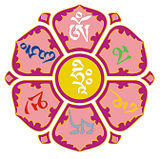
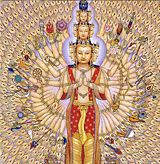
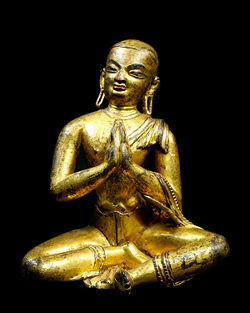
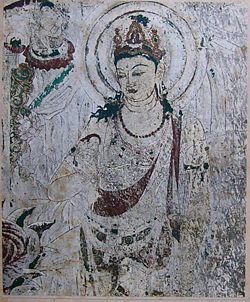
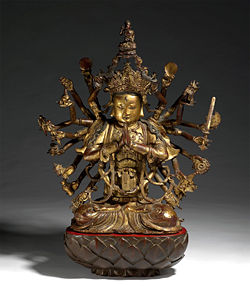


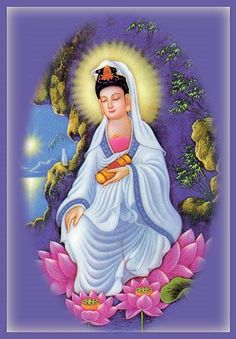
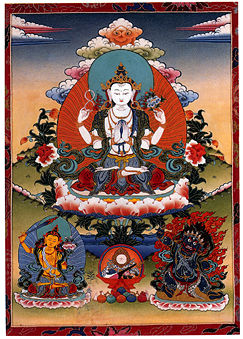
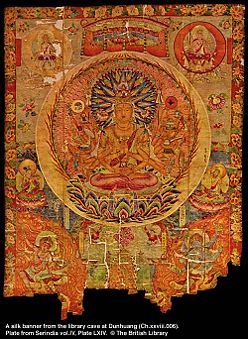

 Русский
Русский
